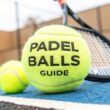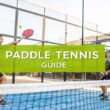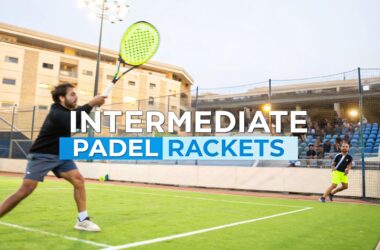Picking the right padel racket isn't just another equipment choice—it's the single most important decision you'll make for your game. It can be the difference between clumsy shots and pinpoint control, or between frustrating games and genuine improvement. The goal is to find a racket that feels less like a tool and more like a natural extension of your arm, perfectly suited to your skill level and how you like to play.
Finding Your Perfect Padel Racket
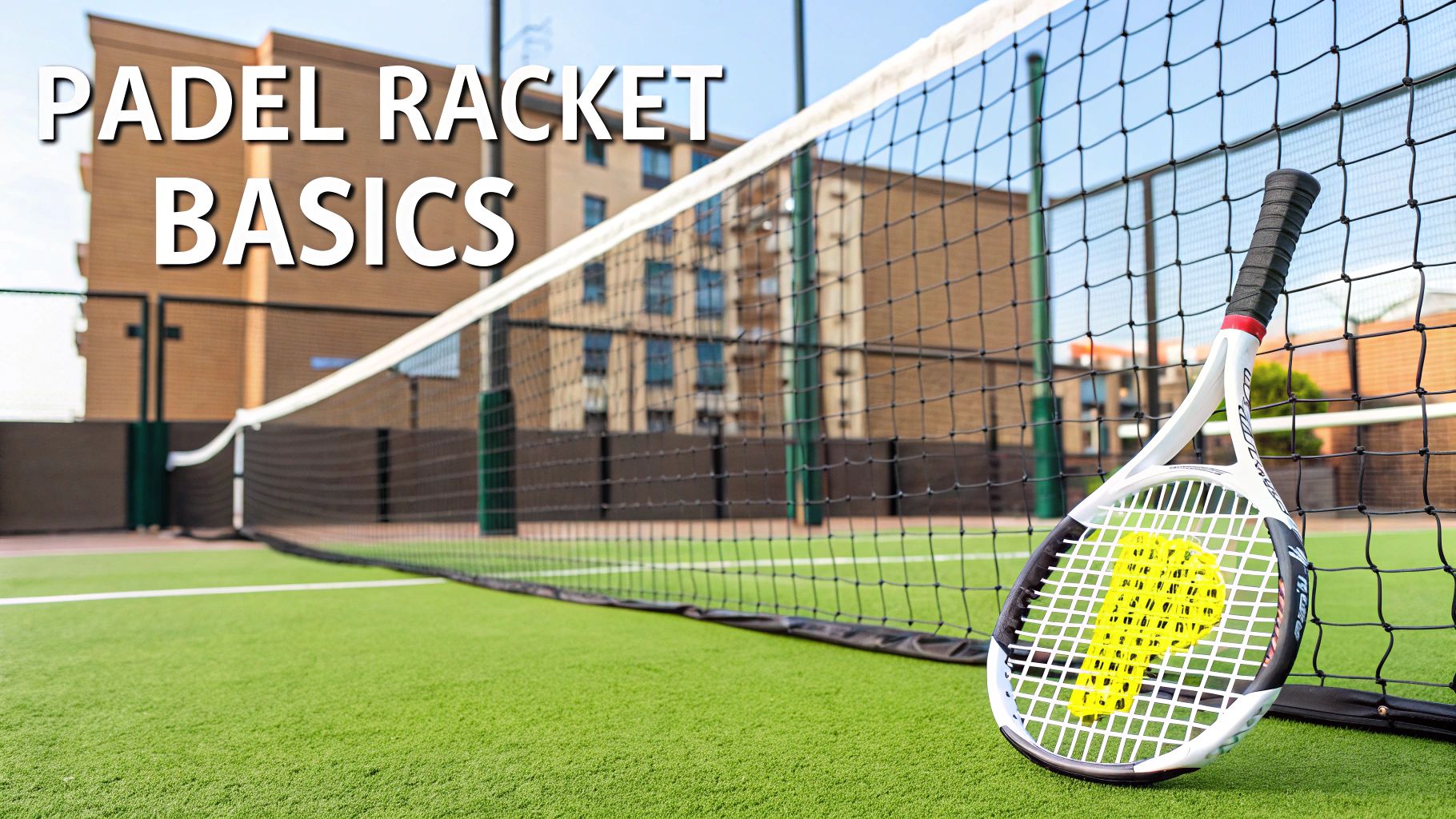
Walking into a shop or browsing online for a new padel racket can feel overwhelming. You're hit with a wall of different brands, wild shapes, and technical jargon. But don't worry, it doesn't have to be that complicated. This guide is here to cut through the marketing fluff and give you some real, experience-based advice to help you choose with confidence.
We're going to get into the why behind different racket features. It's one thing to know a racket is "diamond-shaped," but it's another to understand how that design directly translates to more power on your smash. Think of this as your personal consultation to find a racket that helps you win more points and, most importantly, have a lot more fun on the court.
The Padel Boom and Your Options
The explosion of padel's popularity has been incredible to watch, and it's completely changed the equipment landscape. The global padel rackets market was valued at around USD 130.91 million in 2024 and is on track to hit about USD 413.42 million by 2033. That’s a massive jump, with a growth rate of roughly 13.63% every year, all thanks to new players like you picking up the sport across Europe and the Americas.
What does this mean for you? More choice. Brands are innovating like crazy, rolling out new materials and designs to cater to every kind of player, from the steady, defensive wall to the aggressive, all-out attacker.
Your goal isn't just to buy a padel racket; it's to invest in the right one for your game. The perfect racket makes playing feel easier, helps prevent injuries like tennis elbow, and genuinely speeds up how quickly you improve.
A Simple Framework for Your Decision
Before we dive deep into the technical details, let's get a bird's-eye view. Making a smart choice comes down to just a few core elements that define how a racket behaves. If you're just looking for top-tier recommendations, you might want to check out our guide on the best padel racket selections on the market right now.
For everyone else, here’s what you need to think about:
- Your Player Level: Are you a beginner who needs forgiveness and control, or an advanced player chasing every last bit of power?
- Racket Shape: Round, teardrop, or diamond? Each one offers a different mix of control and power.
- Weight and Balance: This is all about how the racket feels in your hand—is it quick and easy to move, or does it have a heavy head for powerful shots?
- Core and Face Materials: The stuff the racket is made of (the foam inside and the fiber on the face) determines its feel, from soft and comfortable to stiff and responsive.
Quick Padel Racket Selector
To make this even simpler, here’s a quick-reference table. Use it to match racket shapes with your player level and immediately get a sense of where you should start your search.
| Racket Shape | Best For Player Level | Main Advantage | Play Style Focus |
|---|---|---|---|
| Round | Beginner to Advanced | Maximum Control | Defensive, Precision |
| Teardrop | Intermediate-Advanced | Versatility (Power & Control) | All-Around, Hybrid |
| Diamond | Advanced | Maximum Power | Aggressive, Attacking |
This table gives you a fantastic starting point. As you read through the rest of this guide, keep these fundamentals in mind. By matching these core features to your own game, you'll be well on your way to finding a racket that feels like it was made just for you.
Matching Your Racket to Your Player Level
Your skill level is, without a doubt, the most important thing to consider when you’re shopping for a new padel racket. It’s a classic mistake I see all the time: a player fighting against a racket that’s either too advanced or too basic for their game. This is the fastest way to stall your progress and, frankly, ruin your fun on the court.
Let's walk through what works best at each stage of your padel journey.
For the Beginner Finding Their Footing
When you're just starting, the game is all about one thing: consistency. You need to get a feel for the ball and simply get it over the net reliably. This is exactly why a round-shaped padel racket is the go-to choice for almost every new player.
These rackets are designed with a huge, centrally located sweet spot, which makes them incredibly forgiving. Think of it as a built-in safety net. Even when your swing isn't perfect and you hit the ball off-center, a round racket helps correct the shot and send it roughly where you were aiming. This is a massive confidence booster. You'll spend way less time getting frustrated and more time actually learning the core strokes and tactics.
The focus here is purely on control. You're learning to place the ball before you even think about hitting it hard. This principle isn't unique to padel; many racket sports follow a similar logic. For a wider view, you can check out general tips for choosing a racket based on player level from adjacent sports.
For the Intermediate Player Adding Aggression
Okay, so you're past the beginner phase. You can defend the back glass, your lobs are pretty consistent, and you're holding your own in rallies. Now you want to start ending points with a bit more punch.
This is where the teardrop-shaped racket shines. It’s the perfect bridge between the forgiving nature of a beginner racket and the raw power of an advanced one.
The teardrop shape shifts the racket's balance slightly higher up the face compared to a round model. What does this mean for you? A noticeable power increase on smashes and volleys, but without giving up too much of the control you've worked hard to develop. It’s the ideal setup for an all-around player who mixes solid defense with aggressive net play. If you feel like your round racket is capping your offensive potential, a teardrop is the logical next step.
A common pitfall is jumping straight from a beginner racket to a pro-level power racket. This almost always backfires. The smaller sweet spot and unforgiving feel can completely destroy your consistency. The teardrop offers a balanced, manageable step up.
For the Advanced Competitor Seeking Dominance
Once you're at an advanced or competitive level, the game becomes about capitalizing on tiny opportunities and overpowering your opponents. This is the territory of the diamond-shaped padel racket. These rackets are unapologetically head-heavy, with most of their mass concentrated at the top.
This design essentially turns the racket into a hammer, letting you transfer maximum force into the ball for explosive smashes, hard bandejas, and biting viboras. But all that power comes with a trade-off. The sweet spot is much smaller, located high on the face, and offers very little forgiveness on off-center hits.
A diamond racket in the wrong hands is a recipe for unforced errors. It demands precise technique and is really only suited for players who consistently generate their own power and have the skill to manage its demanding nature.
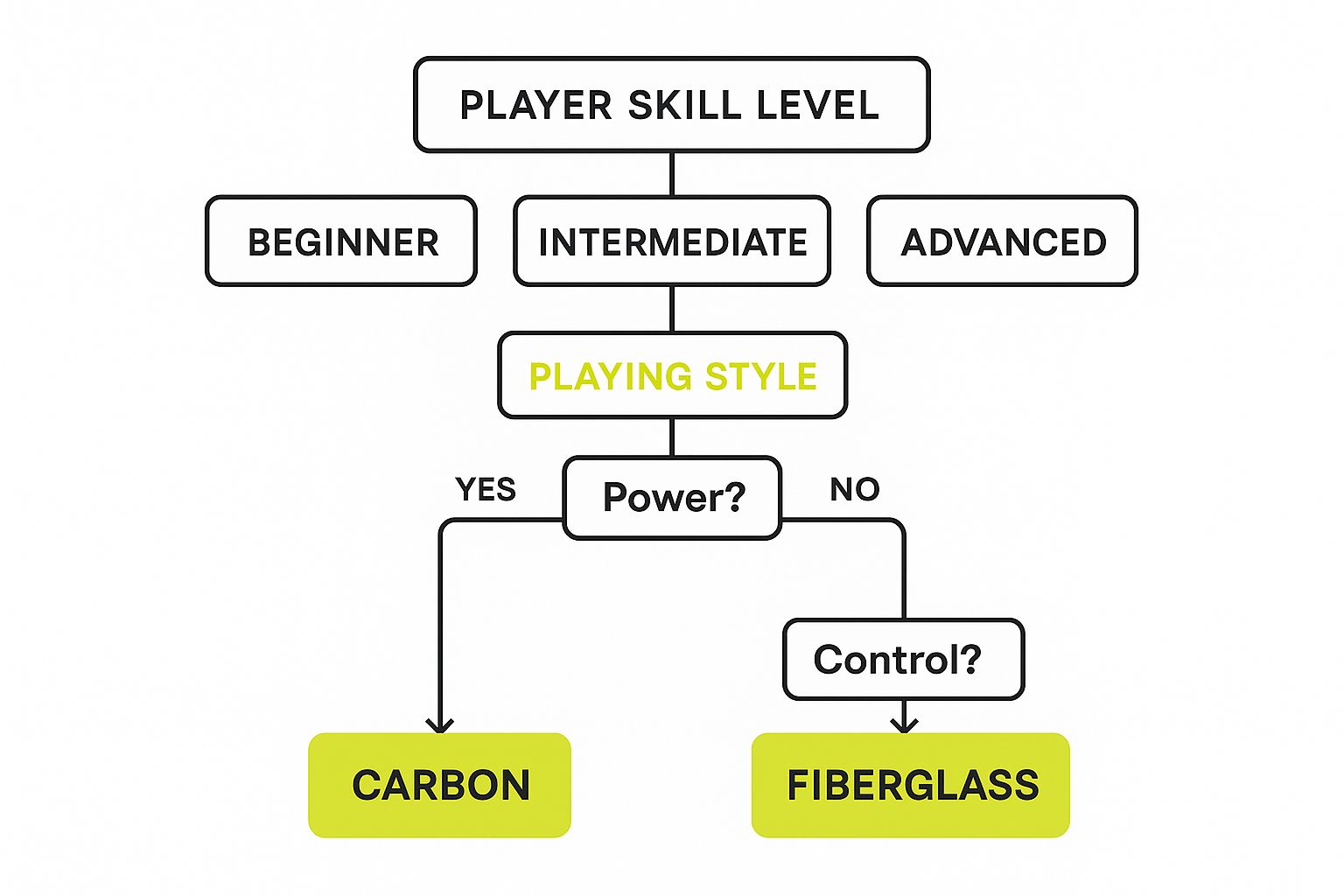
This decision tree helps visualize how your level and style lead to the right racket material. As the infographic shows, beginners should stick with forgiving fiberglass, while advanced players can handle the responsive feedback of carbon fiber. It's worth noting, if you're a beginner coming from another racket sport like pickleball, you might adapt a bit faster. If you want to dive deeper into how the two sports compare, you can read our detailed breakdown of padel vs pickleball.
How Racket Shape and Balance Affect Your Game
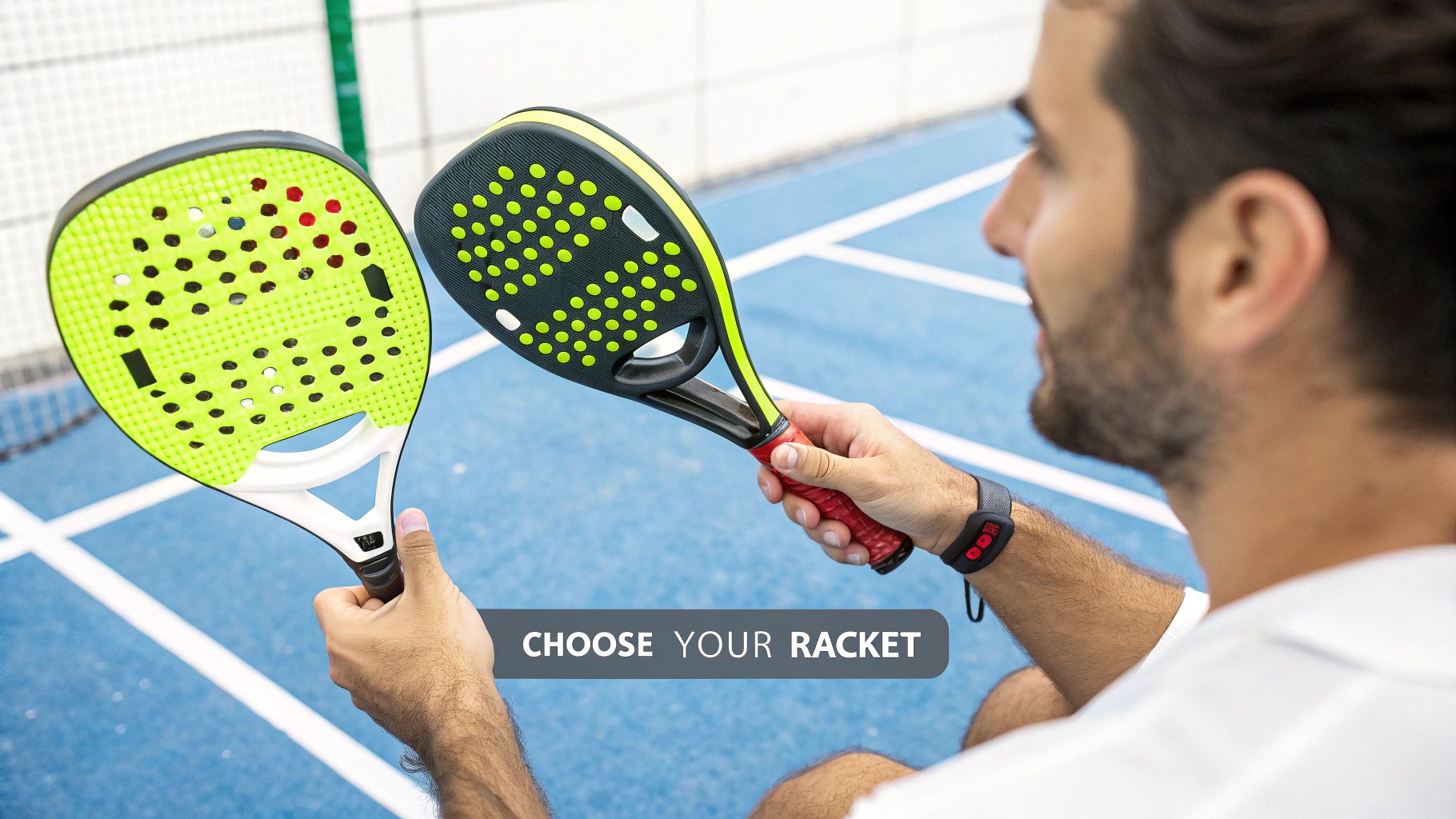
When you look at a wall of padel rackets, you’ll immediately notice three distinct shapes: round, teardrop, and diamond. This isn't just about aesthetics. The shape is the single most important factor determining a racket's balance, and that balance completely changes how it feels and performs on the court.
Getting a handle on this relationship is the key to finding a racket that works with your game, not against it.
A racket’s balance is simply its center of gravity. A quick way to find it is to balance the racket on your finger. Is the weight shifted toward the top (head-heavy), toward the handle (head-light), or is it right in the middle (even)? This one characteristic defines the classic trade-off between raw power and pinpoint control.
Round Rackets for Supreme Control
If you’re a player who prioritizes precision and defensive mastery, a round padel racket should be at the top of your list. The circular shape naturally places the weight closer to your hand, creating a head-light balance.
This makes the racket feel incredibly nimble and easy to swing. You can react faster at the net and place defensive shots like lobs and chiquitas with confidence. The combination of a low balance point and a large, centered sweet spot gives you maximum forgiveness and control. For the strategic player who constructs points patiently, the round shape is a perfect match.
Diamond Rackets for Explosive Power
At the other end of the spectrum, you’ll find the diamond-shaped racket. This thing is built for one purpose: generating explosive power. By packing more mass into the top of the frame, it creates a very distinct head-heavy balance.
Swinging a diamond racket feels like wielding a hammer. That top-heavy momentum lets you plow through the ball, creating devastating smashes and venomous bandejas. But all that power comes at a price. The sweet spot is smaller and higher up on the face, making it much less forgiving and harder to control on off-center hits. This is a tool for aggressive, technically sound players who can consistently find that sweet spot.
The core principle is simple physics: a head-heavy racket gives you more leverage and momentum for power, while a head-light racket offers superior speed and maneuverability for control. Your job is to decide which of these attributes is more valuable to your personal style of play.
Teardrop Rackets: The Versatile Hybrid
Stuck in the middle? The teardrop-shaped padel racket is the happy medium, sitting perfectly between the two extremes. It typically features a versatile, even balance that delivers a fantastic blend of both power and control.
This makes it an incredibly popular choice for the all-court player—someone who feels just as comfortable grinding out points from the back as they do finishing them at the net.
This kind of design innovation is a global phenomenon. Europe, especially padel-obsessed countries like Spain and Italy, is the powerhouse market for padel gear. This has sparked intense competition among brands to engineer rackets for every conceivable playing style and skill level. You can see more on the global padel racket market trends on globalgrowthinsights.com.
Ultimately, you have to feel the difference for yourself. When you're trying out a racket, forget the specs for a second and just pay attention to how it feels to swing. Is it quick and whippy? Or does it feel substantial and powerful as it moves through the air? Answering that simple question will point you straight to the racket that’s right for you.
The Importance of Racket Materials and Weight
Beyond the shape and balance, the real soul of a padel racket is found in its materials. What's packed into the core and layered on the surface directly impacts everything—from how the ball feels when you hit it to how your arm holds up after a long match. Getting a handle on these components is a massive step toward finding a racket that just clicks with your game.
Think of the racket's core as its engine. This internal foam is what determines the racket's power and how much the ball "springs" off the face. For most players, and especially those just getting into the sport, a core made from soft EVA foam is the way to go. This softer material acts almost like a trampoline, absorbing the ball's impact and then launching it forward with less raw effort from you.
This forgiving quality results in a much larger and more generous sweet spot. It's a real game-changer for players still developing their technique, offering fantastic ball output and comfort while minimizing the nasty vibrations that can lead to arm fatigue or the dreaded "padel elbow."
The Racket Face: Fiberglass vs. Carbon Fiber
Working hand-in-hand with the core is the racket's face, or the hitting surface itself. The two most common materials you'll come across here are fiberglass and carbon fiber, and they create very different playing experiences.
A fiberglass face is the more flexible of the two and is usually paired with a soft EVA core. This combination is the ultimate setup for control and comfort. It gives you a soft, almost cushioned feel on every single shot. If you're a beginner or a player who really values precision over pure power, a racket with a fiberglass face is going to feel incredible in your hands.
On the flip side, you'll see most advanced and competitive players reaching for a carbon fiber face. Carbon is significantly stiffer and more rigid than fiberglass. When you combine that with a harder EVA foam core, you get an incredibly powerful and responsive machine. This setup doesn't absorb the ball's impact nearly as much; instead, it channels the full force of your swing directly into the shot. The result is explosive power, but it demands excellent timing and technique to keep it under control.
The key takeaway is this: Softer materials (soft EVA, fiberglass) bring comfort, a bigger sweet spot, and easy power for beginners. Harder materials (hard EVA, carbon fiber) deliver maximum power and a responsive feel for advanced players who can generate their own force.
Finding Your Ideal Racket Weight
Finally, let's talk weight. The overall weight of a padel racket is a critical piece of the puzzle, affecting your maneuverability, stability, and power. Seriously, a difference of just 10-15 grams can completely change how a racket feels and performs on the court.
Here’s a quick breakdown:
- Lighter Rackets (350-365 grams): These are easier to swing fast. That quickness is a massive advantage up at the net where reaction times are razor-thin. The downside? A lighter frame can feel less stable when you’re trying to block a powerful smash from your opponent.
- Heavier Rackets (370-385 grams): These offer superior stability and help you generate more power. The extra mass behind the ball means you can hit harder shots with less effort. However, that heft makes the racket slower to move and can be more tiring on your arm during a long match.
Finding that perfect balance is what it's all about. The global padel sports market, valued at around $228.7 million in 2025, is constantly being pushed forward by these kinds of advancements in materials and design. If you're interested in the business side of the sport, you can read more about the growing padel market and its innovations.
Budgeting and Making Your Final Decision
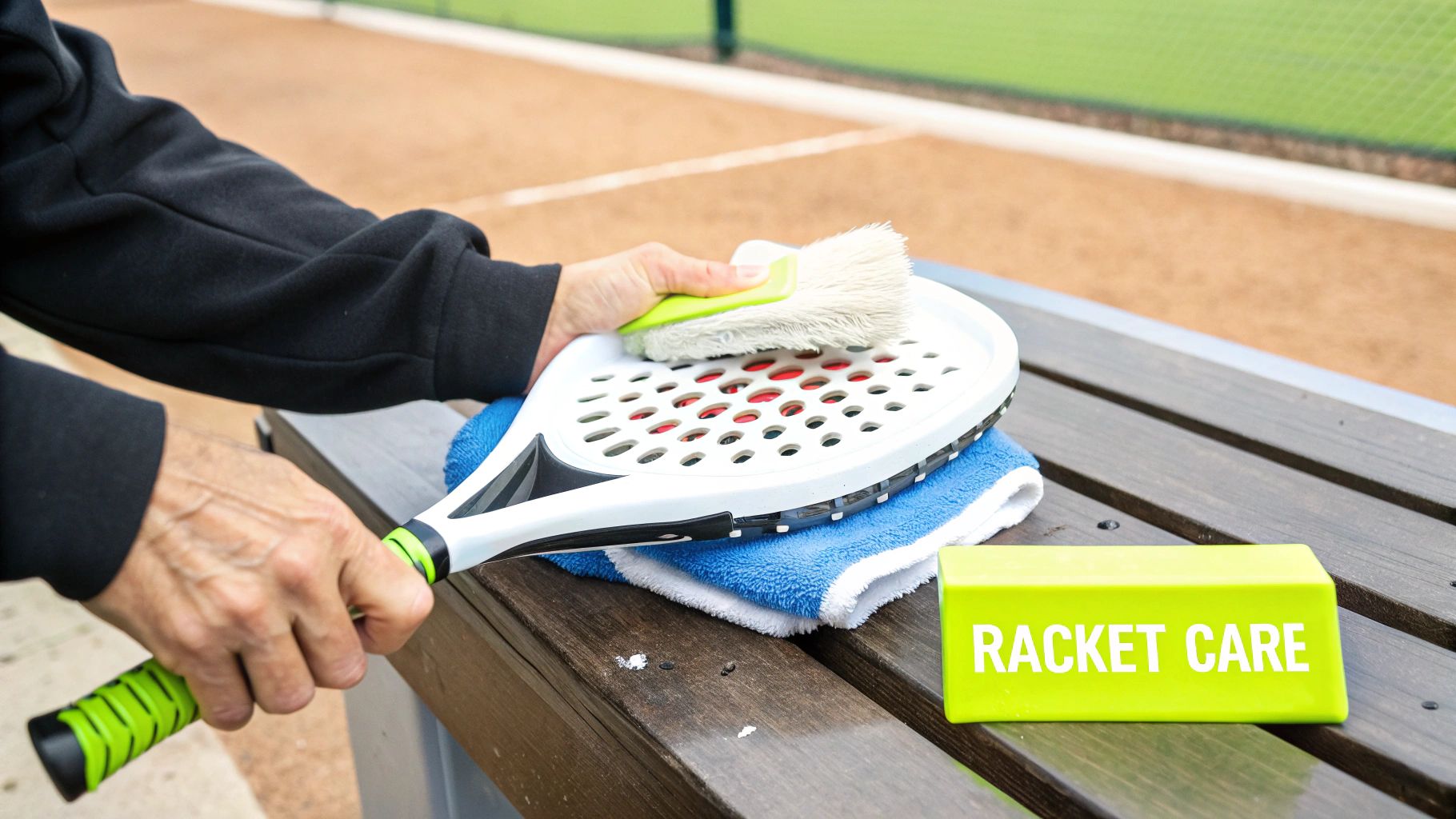
Alright, this is where it all comes together. You've thought about your playing style, you know your skill level, and now it's time to talk money. Let's bust a common myth right away: you do not need to spend a fortune to get a fantastic padel racket. If you know what to look for, there’s incredible value at every price point.
Don't fall into the trap of thinking a high price tag automatically means better performance for you. Sure, that pro-level racket is packed with impressive tech, but if it doesn't suit your game, it's just an expensive paperweight. Honestly, the sweet spot for most players is right in the middle.
What to Expect at Different Price Points
Knowing how cost and features line up will help you find the best racket for your wallet.
-
Entry-Level ($50 – $100): These rackets are your perfect starting point. They usually have fiberglass faces and soft foam cores, which means excellent control, a big, forgiving sweet spot, and a comfortable feel. They're built for durability and learning the ropes without breaking the bank.
-
Mid-Range ($100 – $200): This is the sweet spot for most intermediate players. In this range, you'll find hybrid materials—think fiberglass faces blended with carbon fiber for some extra pop. You also start seeing more advanced foam technologies that offer a great balance of power and control.
-
Premium ($200+): Welcome to the top tier. These rackets boast full carbon fiber construction, textured "gritty" surfaces for wicked spin, and advanced vibration-dampening systems. They deliver maximum power and precision, but be warned: they're stiffer and less forgiving, making them best for advanced players who can truly handle them.
Pro Tips for Finding Great Value
Want to get more bang for your buck? Shop smart.
One of my favorite tricks is to look at last season's top models. Brands launch new lines every year, and the previous year's rackets are often sold at a steep discount, even though the performance is nearly identical. You get almost all the tech for a fraction of the price.
Also, don't underestimate the power of a specialty padel shop. The staff there live and breathe this sport. They can give you personalized advice that you just can't get online and help with everything from grips to game improvement. For more structured help on your technique, it might be worth exploring professional padel coaching.
If you take away only one thing from this guide, let it be this: try the racket yourself. No review or spec sheet can ever replace the feeling of actually hitting a ball with it on the court.
The Final Test: Demo Before You Buy
This is the most crucial step. Most good padel clubs and specialty stores have a demo program where you can test-drive a few rackets for a small fee. This is your chance to see if all your research pays off.
Grab your top contenders and head to the court. Hit some volleys, fire off a few smashes, and play some defensive lobs from the back glass. How does it feel? Does it give you confidence?
This final, on-court test is what confirms you're making the right choice. It ensures the racket you buy truly feels like an extension of your arm and is ready to help you play your absolute best.
Answering Your Final Padel Racket Questions
As you narrow down your choices, a few lingering questions always seem to pop up. It's totally normal. Getting these last few details ironed out is what helps you pull the trigger with confidence. Let's tackle some of the most common things players ask right before they buy.
How Often Should I Actually Replace My Racket?
The life of your racket really comes down to one thing: how much you play. The foam core is a bit like the shocks on a car—it wears out over time and loses its pop.
For a casual player hitting the court once or twice a week, a good racket will easily last you 18-24 months. But if you're a serious, competitive player on the court multiple times a week, that timeline shrinks fast. You'll likely feel the need for a new racket every 9-12 months to keep your game sharp.
Pro Tip: Your racket will tell you when it's time. Listen for a dead, flat sound on impact instead of that crisp "pop." If you see small stress cracks forming on the frame, that's the clearest sign of all. The core is done. Time to upgrade.
Will a Super Expensive Racket Make Me a Better Player?
This is probably the biggest myth in padel. And the short answer is a hard no. In fact, for a beginner, buying a pro-level racket is one of the worst things you can do for your game.
Those expensive, high-end rackets are built for one thing: power. They're stiff, have a tiny sweet spot, and offer very little forgiveness. For a player still developing their technique, this just leads to a mountain of unforced errors and a whole lot of frustration.
The best racket is always the one that fits your current skill level. A great mid-range racket with plenty of control and a generous sweet spot will help you improve way faster than a pro model you can't even control.
What's the Best Racket Weight to Avoid Padel Elbow?
Ah, the dreaded padel elbow. It's a real concern for many players, and your racket's weight is a huge piece of the puzzle.
Generally, a lighter racket (around 350-365 grams) is the way to go if you're worried about arm pain. A lighter frame puts less overall strain on your muscles and tendons with every single swing, which adds up over a long match.
There's a small catch, though. A racket that's too light can sometimes increase vibrations on off-center hits, which isn't great either. The real sweet spot is finding a manageable weight and then focusing on other preventative measures. A good overgrip to absorb shock and, most importantly, solid technique will do more to protect your elbow than anything else.
Do I Really Need a Frame Protector on My New Racket?
Yes. 100% yes. A frame protector is the smartest, cheapest investment you can make for that brand-new racket.
Let's be real—padel involves walls, fences, and frantic lunges. Your racket is going to hit the glass and scrape the court. It’s inevitable. A simple adhesive protector acts as a bumper, taking the brunt of those nicks and scrapes.
It's a shield that protects the frame from the chips and cracks that can kill your racket's durability. For just a few bucks, you can seriously extend the life of your hundred-dollar-plus investment. It's a no-brainer.
Here at Padel Rumors, we're obsessed with helping you find the right gear and improve your game. For more killer reviews, pro news, and the best deals on equipment, check out the rest of our site at https://padelrumors.pages.dev.


